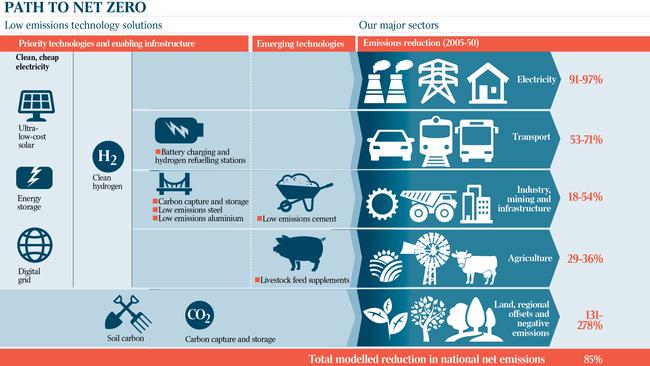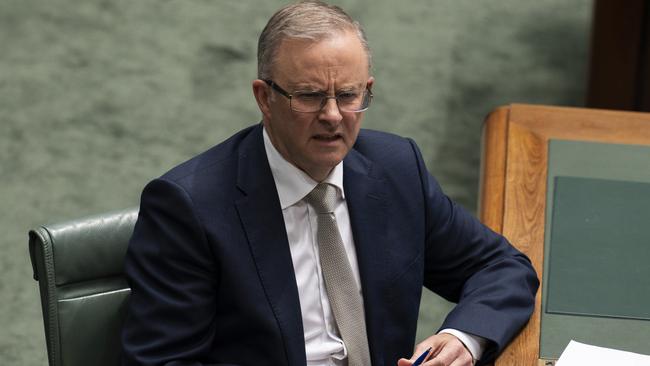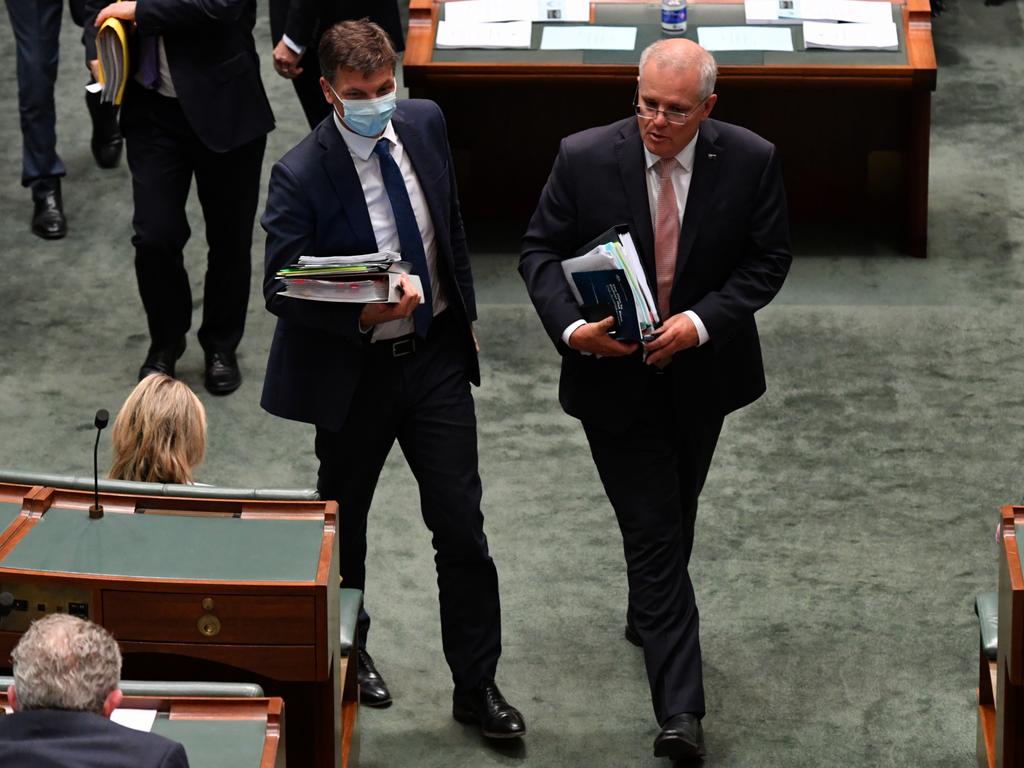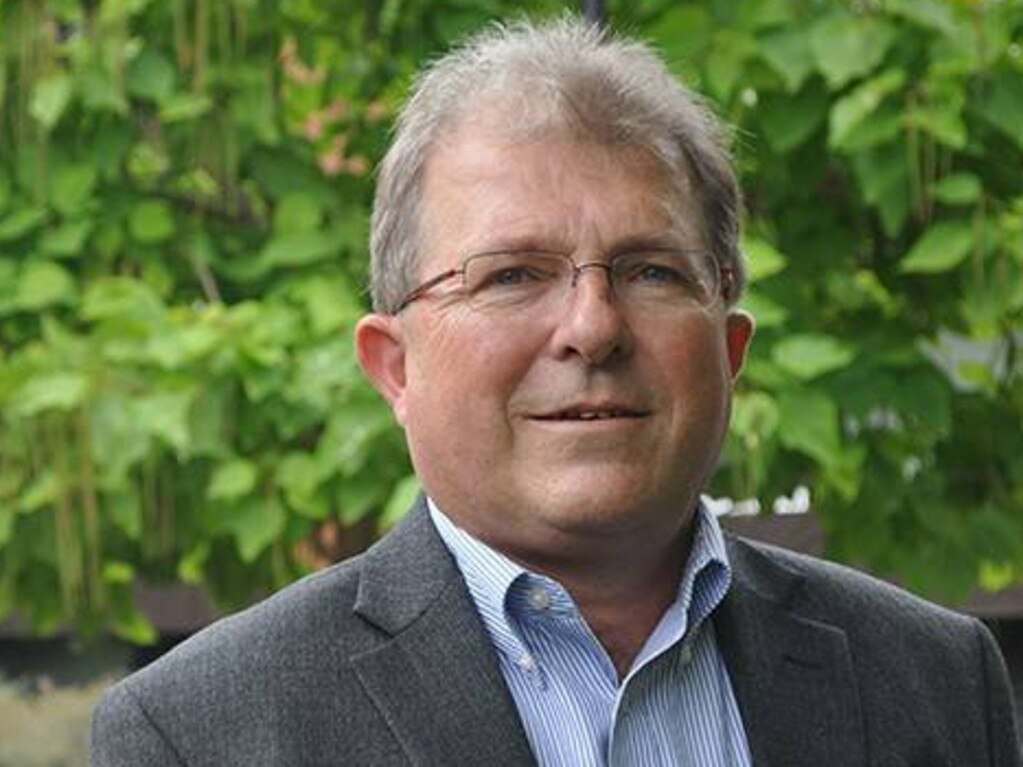Scott Morrison’s $120bn new-tech plunge to hit net zero
Scott Morrison has unveiled a ‘middle path’ to reach net-zero emissions by 2050 and a massive investment for emerging technologies.

Scott Morrison has unveiled a “middle path” for Australia to reach net-zero emissions by 2050 which promises dramatic carbon reductions across the electricity and transport sectors and a massive investment of up to $120bn for emerging technologies to help achieve the Glasgow target.
The Prime Minister on Tuesday announced the government’s 126-page plan, promising it would not cause massive job losses and disruption to the regions and that Australians would be better off by $2000 on average by 2050 compared to taking no action.
The plan, released without economic modelling underpinning its 30-year assumptions, did not include a higher 2030 emissions-reduction target, as the government attempts to wedge Anthony Albanese ahead of the election over more ambitious medium-term goals.

Mr Morrison said the climate-change blueprint — which did not contain any new policies — would be backed by multi-billion-dollar investments in regional infrastructure, renewable-energy projects and low-emissions technologies. These will be finalised ahead of a pre-election budget next year framing the government’s post-pandemic economic strategy.
The government will not legislate its 2050 net zero target, as the Coalition seeks to sharpen distinctions with Labor over how the goal of carbon neutrality by mid-century is best achieved.
“Our plan works with Australians to achieve this goal,” Mr Morrison said. “Our plan enables them, it doesn’t legislate them, it doesn’t mandate them, it doesn’t force them. It respects them. It understands that Australians want to do this.”
The Opposition Leader – who will release Labor’s medium-term emissions-reduction policy next month following the COP26 summit in Glasgow – warned that the refusal to legislate the 2050 target opened the door to future governments backtracking on the climate commitments.
“By their own words there is nothing new in this plan,” Mr Albanese said. “There is net-zero modelling, net-zero legislation, and net-zero unity.

“The fact is that the only reason why there is not going to be legislation about net zero by 2050 … is because the Coalition would be embarrassed by the number of their own members who would cross the floor.”
The “Australian Way” net-zero strategy projects an 85 per cent reduction in national net emissions by mid-century if offsets and international credits are used, and new technologies can slash pollution across the electricity, transport, heavy industry and agriculture sectors.
The remaining 15 per cent will come from technological advancements not yet developed.
Mr Morrison’s net-zero plan banks heavily on the use of soil carbon sequestration and carbon capture and storage to achieve emissions reductions in the land sector of between 131 and 278 per cent on 2005 levels by 2050. This would require the sequestering of 111 million tonnes of pollution a year via CCS technology, the planting of trees and the storing of carbon in the ground, allowing for the widespread use of offsets.

Updated emissions projections show the deployment of more renewables and low-emissions technologies will allow Australia to reduce emissions by 35 per cent on 2005 levels by the end of the decade — an improvement on Tony Abbott’s Paris Agreement target of 26-28 per cent. Under a business-as-usual scenario, emissions projections suggest Australia would still achieve a 30 per cent reduction by 2030.
According to headline estimates from unreleased economic modelling prepared by the Department of Energy and McKinsey & Co, Australians would be almost $2000 “better off on average” compared with a scenario where no climate-change action was taken.
Gross national income would be 1.6 per cent higher and 62,000 new regional mining and heavy industry jobs would be created under the net-zero strategy, which the government said would not raise electricity costs nor put the regions at risk.
Mr Morrison said he would release the net-zero modelling “eventually” and the government would hold a budget next year, hoping to repeat the success of its 2019 pre-election budget. Senior government sources, who expect a May election, said a pipeline of major projects and low-emissions investments were being prepared ahead of the mid-year economic and fiscal outlook, budget and election campaign.
Under the government’s Technology Investment Roadmap, about $20bn of government investment will be funnelled into low-emissions technology by 2030, with up to $100bn leveraged from the public and private sectors as well.
Australia is forecast to reduce its emissions by 65 per cent across the electricity, industrial, agriculture and transport sectors by 2050. Gas and coal production is predicted to be 35 per cent lower in 2050 as global demand for the commodities decline in a decarbonising world. Exports of lithium, nickel and copper would increase to $84bn-a-year.
Amid divisions inside Nationals and Liberal ranks over the climate-change pivot, Mr Morrison said the carbon-neutral strategy was “not a plan at any cost”.
“There’s no blank cheques here,” he said. “It will not shut down our coal or gas production or exports. It will not impact households, businesses or the broader economy with new costs or taxes imposed by the initiatives that we are undertaking. It will not cost jobs, not in farming, mining or gas, because what we’re doing in this plan is positive things, enabling things.”
British Prime Minister Boris Johnson indicated that Australia’s 2050 target would be welcomed at COP26 and described the policy as “heroic” given Australia’s economic dependence on coal and high-intensity export industries. Mr Johnson, who has pressured Mr Morrison on a net-zero target and greater ambition for 2030, said: “World leaders are really starting to listen and see how urgent this is and what an emergency this is.”
Australian Chamber of Commerce and Industry chief executive Andrew McKellar said businesses must have access to the modelling behind the government’s plan but said there was now a “practical and economic transition towards net zero”.
Business Council of Australia chief executive Jennifer Westacott said the bipartisan commitment on net zero by 2050 provided an opportunity to “draw a line under the last decade of division”. She said forecasts showing an emissions reduction of up to 35 per cent by 2030 revealed a “huge opportunity to do some of the heavy lifting earlier and more efficiently”.
Mr Morrison, who will fly to Rome on Thursday to attend the G20 summit before going to Glasgow, said the government’s net-zero emissions policies and regional infrastructure announcements would be released “for everyone to see”. “At the election, there will be a clear choice on who do people trust with the right economic plan to see Australia through this,” he said.
With Mr Morrison preparing to meet South Pacific leaders in Glasgow and pushing to increase regional co-operation on climate change, the government plans to pursue “high-integrity offsets from our Indo-Pacific region”.







To join the conversation, please log in. Don't have an account? Register
Join the conversation, you are commenting as Logout